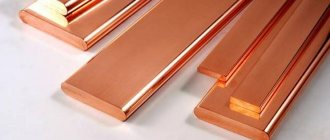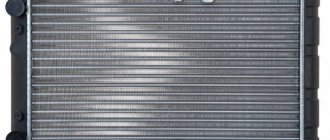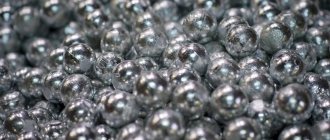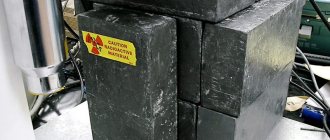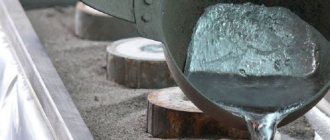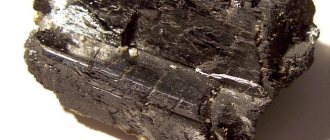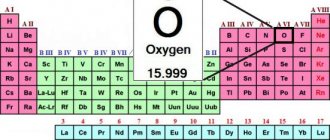History of discovery
Copper is one of the first metals that humanity learned to mine and exploit; According to archaeologists, around the same time as copper, people began to use gold. The fact is that both of these metals occur in nature in their native form, and a piece of copper in order to be used as a tool or weapon simply had to be given the desired shape after heating. This happened, most likely, 6-7 thousand years ago. Gradually, people learned to smelt metal from ore, and slag, indicating the presence of copper metallurgy, was found during excavations of the ancient settlement of Çatalhöyük in Turkey. Initially, weapons and agricultural tools were made from pure metal, but over time, people discovered that when combined with tin, copper produced much stronger bronze.
The difference between aluminum and copper is that the date of its first production is clearly recorded in history. This happened in 1825 in Denmark and the “father” of aluminum was the chemist Hans Oersted. Aluminum does not occur in nature in its native form, but when interacting with oxygen it forms a stable compound, so its production was initially very expensive. The first aluminum was more expensive than gold, and in 1889 the British presented the great Russian chemist Dmitry Mendeleev with scales made of gold and aluminum as a sign of recognition of his services to humanity.
Copper or aluminum wire - which is better?
The most common types of cable for electrical wiring (apartments and industrial premises) are aluminum and copper wires. It should be noted that they are sold nearby on the shelves of our stores. YES, sometimes we can find copper and sometimes aluminum in wiring. So what is the difference and which is better between these two materials? Today I invite you to think about this...
If you studied physics, then of course you know that copper cable has the best electrical conductive properties. Also, this type, unlike aluminum, has an increased service life (aluminum is up to 20 years, but copper is already from 30 and above).
So if you are laying electrical networks in an apartment, then it is preferable to choose copper. And now in detail for each type.
Aluminum cable
Pros:
The big advantage is that the cost of this option is about half cheaper than its opponent (and sometimes even more). That is why all old houses (“STALINKI” and “KHRUSHCHEVKI”) have just such wiring. You know guys, this is probably the only plus, there are many more minuses.
Minuses:
This type of wire can withstand smaller loads compared to its competitor - remember, every millimeter of cross-section can withstand only 1 kW of power.
As I wrote above, the service life of an aluminum cable is only 20 years, so it is not recommended to install it in the wall, otherwise, after this period has expired, you will need to pick at the walls.
Another disadvantage (for me personally) is the inconvenience of installation. Such wires (as a rule) are single-core rigid, so if you use a cross-section of 3.5 mm, connecting them to sockets is quite problematic.
Copper cable
Pros:
This type can withstand high loads - 1 millimeter of cross-section can withstand 2 kW of load, which is twice as much as that of the enemy.
The service life is much longer; according to electricians, they can last 50 years.
There are plenty of types and designs of such wires, these include single-core and multi-core versions, having a practically non-melting braid (NYM cable), etc. Installation of a multi-core cable is much easier, it can be easily connected to a standard outlet, and it bends perfectly.
Minuses:
It's just the price. Technological wires (those with many cores and high-tech braiding) can cost up to two times more than a competitor.
A short comparison video - you can see the price and flexibility.
Useful tips
1) If you design the wiring yourself, then definitely choose copper. After all, with a smaller cross-section, it can withstand a fairly high voltage. That is, it will take up exactly half as much space. So a simple example - if I connected my hob with aluminum (let me remind you that its power is about 7.5 kW), then I would need a core cross-section of about 8 mm, and there are three of them in the cable, and even a braid - that is, the thickness would be about 4 – 5 cm, not a weak wiring! But copper can withstand a cross-section of 4 mm (total diameter about 2 cm), which is also quite a lot, but tolerable.
2) When designing sockets, the first thing you need to remember is that the wire must have three cores (grounding is required). Make the distance between them 2 meters, and the distance from the floor 30 cm, this is the EUROPEAN STANDARD. For lighting, you can use a two-wire version, since the load is minimal and there is practically no need for grounding.
3) Do not hang all electrical equipment on one wiring, the load will be very large! You need to make a branch, preferably for each room. The kitchen is especially worth highlighting. For the main cores for rooms, I advise you to take a cross-section from 4 mm, for the kitchen from 6 mm.
4) We bought an old apartment, it’s more than 20 years old, look at the wiring. Most likely, there is aluminum and it needs to be changed because after such a period it loses its elasticity and simply crumbles. This is often the cause of fires. “YES”, such a replacement will cost a pretty penny, but the game is worth the candle, because it’s your safety.
This is the choice, I think - now you will buy the right copper wire, aluminum is too difficult to install, and also short-lived.
I’ll finish here, read our construction blog.
remo-blog.ru
Comparison
The electrical conductivity of copper is one and a half times higher than that of aluminum, but the density of aluminum is 3.3 times less than that of copper. There is no need to talk about the price - after the development of industrial technology for the production of aluminum, its cost has fallen very much and now it is significantly less than that of copper. These circumstances predetermined the use of aluminum for the production of multi-core wires and cables. Please note when you see high voltage power lines: all wires are made of aluminum. It’s cheaper this way and the load on the supports is much lower. Well, if the electrical conductivity is less, you have to put up with it.
Copper is also used to produce bronze. In ancient times, bladed weapons and tools were made from it until iron smelting was mastered. But later, guns were cast from bronze, and this continued for quite a long time, until the 19th century. The Tsar Cannon and the Tsar Bell were cast from bronze. In addition, due to its high corrosion resistance, copper has found application in the manufacture of pipes for transporting various liquids and gases, as well as in some other industries.
Aluminum is called the “winged metal”. This name speaks of the second large-scale area of its application (after electrical engineering). When aluminum (95.6%) and copper (4.4%) are combined, an alloy is obtained, which is called duralumin, or duralumin. Having a density close to that of aluminum, it has significantly higher strength characteristics, which is why it is widely used for aircraft production.
Useful tips
The wire connection must comply with safety regulations
The cable layout in the apartment consists of an upper and lower level. The lower one has sockets designed to power consumers, the power of which can reach 2 kW: washing machines, boilers, microwave ovens. In order not to expose the lines to the risk of overheating and burning, it is advisable to install a copper cable with the maximum cross-section of conductors allowed for household outlets.
The upper level is used to power doorbells, ceiling and wall lamps. These products consume a minimal amount of electricity, especially if they are equipped with modern LED lamps. You can run a thin and inexpensive aluminum cable on top, the power reserve of which is sufficient with a large reserve. With this solution, a separate issue arises of a safe way to join two incompatible metals.
Conductive paste
To avoid problems with contacts after installation, you can use one of the following devices:
- Clamp. The product consists of 3 steel plates. The cores are inserted between them, after which the plates are tightened with bolts.
- Bolt with 2 iron washers. The ends of the cores are twisted into rings and placed on the axle, and washers are installed between different materials. Tightening the nut ensures reliable contact.
- Spring switch. Its terminals are treated with a special anti-corrosion lubricant. The cores are inserted into the grooves and secured with spring levers.
- Pads. They are a steel strip with contacts pressed into a plastic case. The ends of the cable are inserted into the holes where they are tightened with bolts. The products can be used to connect 2-10 pairs of wires.
How to distinguish copper from other metals
For most of us, knowledge about copper and its properties is limited to a school chemistry course, which is quite enough at the everyday level. However, sometimes there is a need to reliably determine whether a material is a pure element, an alloy, or even a composite material. The opinion that this information is needed only by those who are engaged in the acceptance or delivery of scrap metal is erroneous: for example, on amateur radio forums, topics are often raised about how to distinguish copper in wires from copper-plated aluminum.
Copper
Pure copper ranks next in electrical conductivity after silver, which has the highest conductivity of all known conductors. High conductivity and resistance to atmospheric corrosion, combined with high ductility, make copper the main material for wires.
In air, copper wires oxidize slowly, becoming covered with a thin layer of CuO oxide, which prevents further oxidation of copper. Copper corrosion is caused by sulfur dioxide SO2, hydrogen sulfide H2S, ammonia NH3, nitric oxide NO, nitric acid vapor and some other reagents.
Conducting copper is obtained from ingots by galvanic purification in electrolytic baths. Impurities, even in insignificant quantities, sharply reduce the electrical conductivity of copper, making it unsuitable for current conductors, therefore only two grades of copper, M0 and M1, are used as electrical copper.
Almost all conductive copper products are made by rolling, pressing and drawing. Thus, wires with a diameter of up to 0.005 mm, tapes with a thickness of up to 0.1 mm, and copper foil with a thickness of up to 0.008 mm can be produced by drawing.
Conducting copper is used both in annealed form after cold working (soft copper grade MM) and without annealing (hard copper grade MT).
At heat treatment temperatures above 900 °C, due to intensive grain growth, the mechanical properties of copper sharply deteriorate.
In order to increase the creep strength and thermal stability, copper is alloyed with silver in the range of 0.07-0.15%, as well as magnesium, cadmium, zirconium and other elements.
Copper with silver additives is used for windings of high-speed and heat-resistant high-power machines, and copper alloyed with various elements is used in commutators and slip rings of heavily loaded machines.
Briefly about element No. 29
Pure copper (Cu) is a golden-pink metal with high ductility, thermal and electrical conductivity. Chemical inertness in an ordinary non-aggressive environment is ensured by a thin oxide film, which gives the metal an intense reddish tint.
The main difference between copper and other metals is color.
. In fact, there are not so many colored metals: only gold, cesium and osmium are similar in appearance, and all elements included in the group of non-ferrous metals (iron, tin, lead, aluminum, zinc, magnesium and nickel) have a gray color with varying intensity of shine.
An absolute guarantee of the chemical composition of any material can be obtained only through spectral analysis. The equipment for carrying it out is very expensive, and even many expert laboratories can only dream of it. However, there are many ways to distinguish copper at home.
with a high degree of probability.
Aluminum cable or copper? How to choose?
More and more owners of industrial premises are paying attention to which cable to choose for wiring. In this article we will try to give a complete answer to this question.
Aluminum power cable
Aluminum power cable is used more often for laying temporary wiring of three-phase current in a room - usually for 1-2 years, or even months. It is often used by builders during the construction of a building, and then replaced with copper. However, many industrial premises still have aluminum wiring, particularly in industrial buildings from the 1920s to the 1970s, where such wiring is used as regularly as copper wiring.
Today, aluminum power cables are produced with the following protective coatings:
- made of cross-linked polyethylene with a service life of up to 30 years;
- polymer - up to 25 years;
- with processing in the form of a special paste - up to 40 years.
You can buy these products on our website at a competitive price; just open the catalog and fill out an application.
Advantages
The advantages of the product include:
- light weight - this characteristic is important if electrical installation takes place in a dilapidated building or when installing power transmission lines stretching for tens of kilometers, since a large weight will simply pull the wires down, breaking them from their fastenings;
- low cost - the cost of an aluminum power cable is 3 times lower than that of copper;
- upon contact with air, a grayish-blackish film forms on the surface, protecting against oxidation.
Despite all the positive properties of aluminum wires, they have a significant drawback - destruction under the influence of time and relatively low throughput - per 1 square millimeter of aluminum cable area there is only 1 kW of load, while for copper analogues this figure is 2-2.25 kW .
To connect an electrical appliance to a network using an aluminum cable, you need to know the power of the electrical appliances that will be connected to the network. This will allow you to determine the cross-sectional area of the aluminum wire. Having determined the exact cross-section, you need to add about 30-40% to it for overload or connection of other devices. The service life of the wiring is 20-25 years, after which it is destroyed at a rate of 3-8% per year of its original size, which leads to the inability to perform its function.
Copper power cable
Copper power cable today is used much more often for laying indoor wiring due to its low resistivity and the relatively short length of all indoor wiring. Many people claim that copper lasts longer, but this is not entirely true. Many reference books say that copper lasts as long as aluminum, but its problem is not time, but burnout. With a single winding, a copper wire will last about 20-25 years, with a double winding - up to 35 years.
Advantages
The advantages of the product include:
- the ability to withstand a large number of bends - up to 80 at one point;
- good level of current conductivity - 2 times higher than that of aluminum, which allows the use of cables with a less massive cross-section when laying;
- does not collapse over time.
You can order copper cable from our company, you just need to open the catalog, fill out an application or feedback form and our managers will contact you to confirm the order.
How to choose?
Aluminum power cable or copper, how to choose? Quite simple actually. Here you need to choose between an expensive and easy-to-install copper cable and a cheap, but sometimes difficult-to-install aluminum cable. To choose the right one, you need to remember the following:
- the cost of aluminum power wire is 2-4 times lower;
- copper wire is easier to install due to withstanding a large number of kinks;
- the service life is approximately the same and differs by 2-5 years, and sometimes a cheap aluminum cable in a special protective composition is more durable than copper;
- the throughput is better for copper - resistance is 0.018 Ohms per square millimeter versus 0.028 Ohms for aluminum;
- the cross-section of the aluminum cable is approximately 50-60% larger than that of copper if it is necessary to achieve the same level of throughput;
- aluminum wears out from current, and copper can quickly burn out.
Determination by color
So, we have before us a piece of unknown material that needs to be identified as copper. The emphasis on the term “material” rather than “metal” was made specifically, since recently many composites have appeared that are very similar to metals in appearance and tactile sensations.
First of all, we consider color. It is advisable to do this in daylight or “warm” LED lighting (under “cool” LEDs, the reddish tint changes to yellow-green). It is ideal if there is a copper plate or wire for comparison - in this case, errors in color perception are practically eliminated.
Important: old copper products can be covered with an oxidized layer (a greenish-blue loose coating): in this case, the color of the metal must be looked at in a cut or saw cut.
Why was zinc added to copper and why are zinc statues not cast?
Copper is alloyed with zinc to create alloys with properties that copper and zinc do not have individually. Copper is a good conductor of heat and electricity. Copper is ductile, stretches, and can be stamped. Copper wires, copper tubes for refrigerators, heaters or air conditioners, copper utensils fully realize the properties of copper, such as heat and electrical conductivity, and high ductility. Corrosion resistance and chemical inertness to household solutions make it possible to produce copper cookware, frying pans, and pots. But the downside of the properties of copper is that it has insufficient strength, hardness, corrosion resistance and high cost for widespread use in technology as a structural material. For five thousand years, people have been modifying copper by adding other metals to the melt to measure its properties.
Zinc has even lower strength than copper. Unlike copper, it is extremely fragile in the cast state - the relative elongation of cast zinc is δ = 0.5-1%, despite the low cost and good casting properties, monuments are not cast from zinc. After cold rolling or wire drawing, the ductility of zinc increases sharply to δ = 25-60%. Zinc is used as a protective anti-corrosion coating. An oxide film forms on the surface of zinc and protects the metal from corrosion.
An alloy of copper and zinc creates a new structural material - brass, which is superior to its parents in strength, manufacturability, while maintaining high corrosion resistance and ductility.
Read also: Lever mechanical measuring instruments
Determination by magnet
Color matching is a reliable but not sufficient method of identification. The second step of independent experiments will be a test with a magnet. Chemically pure copper is classified as diamagnetic - i.e. to substances that do not respond to magnetic influence. If the material under study is attracted to a magnet, then it is an alloy in which the content of the main substance is no more than 50%. However, even if the sample did not react to the magnet, it is too early to rejoice, since often an aluminum base is hidden under the copper coating, which is also not magnetic (this can be eliminated by filing or cutting).
New properties of brass compared to copper
Alloying copper with zinc and other metals created 12 grades of cast brass and 34 grades of wrought brasses that can be stamped, forged, and drawn. When asked how brass differs from copper, I would like to clarify, but what kind of brass are you asking about? Tompaki - brass L96 and L90 with a high copper content differ little from copper. They are red in color, can be stamped well, and are 2-3% stronger than copper with a loss of ductility. Tompaki can easily be confused with copper.
An increase in the percentage of zinc gives brass a yellow color and increases the strength of the alloy. Brasses with a zinc content of about 30% - L68, L70 are superior to copper in strength by one and a half times and in ductility by 15%.
Add a little lead to a copper-zinc alloy and you get a new type of brass - lead. There is a 99% chance that your kitchen or bathroom faucet is made of lead brass. It is hidden under a layer of shiny chrome or matte nickel. Unscrew the valves from the faucet and look inside, you will see yellow brass. Lead brass not only brings pleasure to lovers of water procedures, but it is loved by turners for its good machinability on machines and is affectionately called “loose”. Lead brass does not produce twisted chips when turning or drilling. Its shavings fall out from under the cutter like golden sand. The difference between copper and brass is that copper is a viscous and soft material, which creates difficulties during machining.
If you need to make a ship's bell, you cannot do without adding tin to the copper-zinc solution. Tin gives pewter brasses seawater resistance and strength for long-term use.
Aluminum brass LA85-0.5 is a material for jewelry. Half a percent of aluminum gives this brass a golden shine, and high ductility makes it possible to produce the finest wire and ribbon for costume jewelry, decorations, and military insignia. Future jewelers learn the secrets of craftsmanship using brass L62 and L68. The technological and mechanical properties of these brasses are close to those of 583 gold alloy, and the cost is disproportionately lower.
How to distinguish between copper and its alloys?
Copper alloys are widely used in industry. Over many years of research, it has been possible to obtain many materials with unique properties: high ductility, electrical conductivity, chemical resistance, strength (all depends on alloying additives). The most common are bronze (with the addition of tin, aluminum, silicon, manganese, lead and beryllium), brass (with the addition of 10-45% zinc), as well as copper-nickel alloys (nickel silver, cupronickel, copel, manganin).
Only bronze and brass are difficult to identify, since copper-nickel alloys differ significantly in color due to their low copper content.
Copper or brass?
Brass can contain from 10 to 45% zinc, a silver-gray metal. Naturally, the more zinc, the paler the alloy. However, high-copper brasses, in which the amount of additives does not exceed 10%, differ little in color from the copper sample. In this case, you can only trust your feelings: brass is much harder and more difficult to bend (for greater reliability, a comparison with a reference sample is advisable). You can try to remove the shavings: copper shavings will have a curl shape, brass shavings will be straight, needle-shaped. When the samples are placed in a solution of hydrochloric acid, no reaction with copper is observed, and a white coating of zinc chloride forms on the surface of the brass.
Copper or bronze?
Like brass, bronze is much stronger, which is explained by the presence of harder metals in the alloy. The most reliable test will be a “tooth test” - there is unlikely to be a trace of pressure left on the surface of the bronze.
You can also experiment with a hot saline solution (200 g of table salt per 1 liter of water). After 10-15 minutes, a copper sample will acquire a more intense shade than a bronze one.
Properties of aluminum wiring
Aluminum wiring is resistant to mechanical stress
Aluminum is not the best option for indoor wiring, but the material has several advantages over its analogues. We are talking about low weight, which greatly simplifies installation work, provided that a large amount of aluminum cable is required. The cost is lower compared to copper. These two main advantages became decisive when choosing types of wiring during the construction of structures in the USSR.
Another important feature of the material is its resistance to corrosion. However, aluminum is highly oxidized when exposed to air. As a result, a film is formed that serves as protection against further damage to the wiring. This film has poor conductivity, which can be attributed to another disadvantage.
- When oxidized, copper does not lose its conductive properties.
- Has a long service life.
- The material is more resistant to mechanical stress, for example, bending, twisting, etc.
During oxidation, films are formed in both cases, but each has different conductive properties.
Aluminum fluidity
Aluminum is several times softer than copper
First of all, you need to know about the physical and chemical properties of aluminum. The substance belongs to the group of fluid metals; it is several times softer than copper. This is a significant drawback, since homeowners need to regularly check and, if necessary, tighten all screw contact points, for example, in sockets, automatic machines and terminal blocks. This is very inconvenient if there are 10 or more sockets in the house, which need to be disassembled, tightened and installed in their original place every six months.
Flexibility and fragility
The second feature of aluminum cores is fragility and fragility. If you bend them several times, they will break off without much effort. It takes a lot of effort to deform copper.
Connecting aluminum to machines
Aluminum and copper are not galvanically compatible
The third feature of the material is the contacts of switching equipment. For RCDs, switches, voltage relays, contactors, terminal blocks and starters, they are initially made of copper or brass.
If you directly connect brass-aluminum = copper-aluminum contacts, a galvanic couple is formed, accompanied by strong heating of the junction and the formation of oxides.
Core cross-section
Another feature of aluminum wiring is the need to increase the cross-section of the wiring strands. If previously it was enough to use cables with copper conductors of size 2.5 mm2, now there is a need to lay at least 4 mm2.
For those familiar with electrical engineering
Very often, copper cores from electrical cables are sold as scrap non-ferrous metals, and there are often cases when copper-coated aluminum is used in the production of electrical products. This material has a significantly lower density, but due to its irregular geometric shape, determining the volume to calculate the density is quite difficult. In this case, copper can be determined by electrical resistance (of course, if you have the appropriate instruments - a voltmeter, ammeter, rheostat). We measure the cross-section and length of the core, take instrument readings, and Ohm’s law will help you. Resistivity is a fairly accurate characteristic by which any metal can be identified with a high degree of reliability.
Which wiring material is better?
Types of copper wire connections
With all the advantages of aluminum, one should not forget about its disadvantages. The main one, apart from mechanical characteristics, is low conductivity. It is impossible to endlessly increase the diameter of the cable, since household appliances and channels laid in the walls are not designed for this. We should not forget about such a factor as the fragility of the metal. After several years of use, it may burst when replacing an outlet or meter. It is not advisable to twist it in the socket box, as it will not last long. Choosing aluminum will provide good savings on the purchase of materials, but subsequent repair costs may negate this.
Copper also has its disadvantages, but they are offset by a large number of advantages. Even the process of pulling the cable through the channel is easier, since it bends well without any tendency to break or break. It is worth remembering about low resistance. By installing a line with 2.5 mm² conductors, you can use as powerful consumers in your home as the common house line allows.
To summarize, we can recommend that craftsmen make their choice in favor of copper products. If the budget is limited, you can combine materials using modern switching means.
Copper or Aluminum: Which is Best for Wiring?
Nowadays, the vast majority of electricians use copper wiring instead of aluminum. But why? Why is copper better than aluminum? The answer is in our article.
In the USSR, all wiring was aluminum, but in modern new buildings you will no longer see such wiring. But why is copper better than aluminum? Which wiring is better for your home: copper or aluminum? We tell you why the material of the wires changed so quickly and irrevocably.
Which wiring material is best?
Now let's look in more detail which wire is better, copper or aluminum. In this regard, many stereotypes and misconceptions have appeared, which we will discuss below:
Durability. It is believed that the lifespan of copper wire is longer than aluminum. This is a misconception. If you look at a special reference book, you can make sure that the service life of cables made of both types of metal is identical. For products with single insulation it is 15 years, and for products with double insulation - 30. Tendency to oxidation. When using an aluminum cable, it is worth remembering its tendency to oxidative processes. Back in school, we were told that Al (aluminum) is a metal that actively interacts with oxygen, which is why a thin film appears on its surface. The latter protects the metal from further decay, but impairs its conductivity. If the wire is isolated from the environment, the risk of oxidation processes is minimized. The best option is to use special terminal blocks with conductive paste. The peculiarity of the latter is to improve the quality of the contact connection between two wires and remove the oxide film from the metal. In addition, a special lubricant prevents aluminum from coming into contact with the surrounding air. Strength. Copper wiring is considered more durable and can withstand repeated bending. GOST states that a wire made of copper must withstand 80 kinks, and one made of aluminum - 12. If the wiring runs in the wall, floor, or is hidden under the ceiling, this feature is not so important. Price. The price of aluminum wire is 3-4 times lower
But when choosing, it is important to remember that a copper wire with a cross-section of 2.5 sq. mm is designed for a current of 27 Amperes. If you give preference to aluminum wiring, the wire thickness should be 4 kW
mm (rated current 28 Amps). Resistance. When deciding whether to choose aluminum or copper wires, it is worth considering different resistivities. For copper, this parameter is about 0.018 Ohm*sq.mm/m, and for aluminum - 0.028. But it is worth considering that the total resistance (R) of the conductor depends not only on the mentioned parameter, but also on the length and area of the conductor. If we take into account that aluminum wires of a larger cross-section are used for the same load, the final R of copper and aluminum products will be approximately identical. The greatest resistance occurs at the joints, but if you follow the tips discussed above, you don’t have to worry about this. Ease of installation. It is believed that connecting aluminum wires is a more difficult task. This is only relevant for the usual connection of wiring, by twisting. In the case of using end caps, terminal blocks or bolts, this problem disappears.
A situation involving contact between two different metals deserves special attention. When copper and aluminum combine at the point of contact, various processes occur, due to which the resistance increases. As a result, the junction of the two wires overheats, the insulation is destroyed and the risk of fire increases.
The feature discussed above is characteristic of all metals having different resistivities. In addition, many manufacturers do not use “pure” metals, but their alloys, which also leads to a change in the resistance parameter. To avoid problems in the future, it is better to connect the wires correctly and avoid twisting them.
The superiority of aluminum over copper for power lines
But aluminum is not retired at all: overhead power lines are still made of this metal. So it also has advantages? Certainly!
Weight
Weight is largely determined based on the density of the metal. The higher the density, the heavier the conductor. The density of copper is 8900 kg/m3, and that of aluminum is 2700 kg/m3. That is, with an equal volume, a copper wire will weigh 3.3 times more than aluminum. For home wiring this is not critical, since the wire lies in the grooves, but for overhead power lines this is an important indicator. That is why aluminum wire is used for overhead power lines.
Weight and electrical conductivity
Perhaps not the last factor when choosing between aluminum and copper conductors is their electrical conductivity. Yes, of course, copper has better conductivity per unit volume, but aluminum is lighter, and this is its big advantage. According to Uwe Schenk, manager of Helukabel, “Raw Al is approximately 70% lighter than Cu. And aluminum bars and cables are about 60% lighter than copper.”
However, the main indicator is still conductivity. Al grade Al6101 has almost half the conductivity of Cu (56%). The difference in the ratios of mass and electrical conductivity looks something like this: for one pound of Al there is approximately 1.85 pounds of Cu. For example, a copper bus bar assembly weighs 550 pounds and an aluminum bar assembly weighs 300 pounds. This difference in weight can help save not only on materials, but also on transportation and even loading and unloading.
Comparative characteristics
The appearance of brass depends on how much copper it contains. If more than 80%, then it will be very difficult to distinguish the alloy. However, the more zinc, the lighter the shade; it loses its reddish notes and becomes more yellow. Let's compare the general physical characteristics of these materials:
| Index | Copper | Brass |
| Weight | Heavier | Easier |
| Color | Pinkish brown | Golden yellow |
| On impact | Low sound | Alt |
| Density | Plastic | Solid |
| Shavings | Spiral | Needle |
As follows from the table, despite their similar composition, copper and brass are very different in both chemical and physical characteristics.

